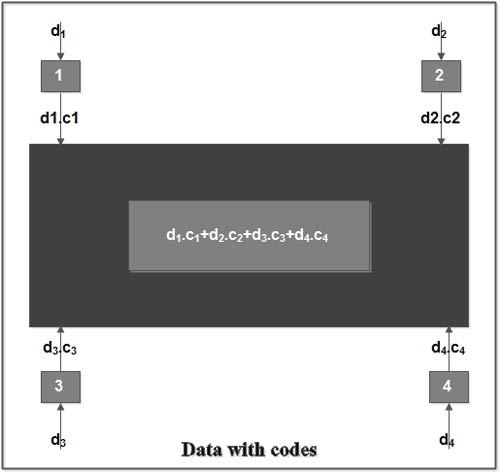CDMA (Code Division Multiple Access) also called spread-spectrum and code division multiplexing, one of the competing transmission technologies for digital MOBILE PHONES. The transmitter mixes the packets constituting a message into the digital signal stream in an order determined by a PSEUDO-RANDOM NUMBER sequence that is also known to the intended receiver, which uses. it to extract those parts of the signal intended for itself. Hence each different random sequence corresponds to a separate communication channel. CDMA is most used in the USA.
• Unlike TDMA, in CDMA all stations can transmit data simultaneously, there is no timesharing.
• CDMA allows each station to transmit over the entire frequency spectrum all the time.
• Multiple simultaneous transmissions are separated using coding theory.
• In CDMA each user is given a unique code sequence.
• The basic idea of CDMA is explained below:
1. Let us assume that we have four stations 1, 2, 3 and 4 that are connected to same channel. The data from station 1 are dl, from station 2 are d2 and so on.
2. The code assigned to first station is C1, to the second is C2 and so on.
3. These assigned codes have two properties:
(a) If we multiply each code by another, we get O.
(b) If we multiply each code by itself, we get 4. (No. of stations).
4. When these four stations are sending data on the same channel, station 1 multiplies its data by its code i.e. dl.c1}, station 2 multiplies its data by its code i.e. d2 .C2 and so on.
5. The data that go on channel are the sum of all these terms as shown in Fig.

6. Any station that wants to receive data from one of the other three stations multiplies the data on channel by the code of the sender. For example, suppose station 1 and 2 are talking to each other. Station 2 wants to hear what station 1 is saying. It multiples the data on the channel by CI (the code of station 1).
7. Because (C1. C1) is 4, but (C2. C1), (C3. C1), and (C4. C1) are all zeroes, station 2 divides the result by 4 to get the data from station 1.
data = (dl . C1+ d2 . C2+ d3. C3+ d4. C4) • C1
= dl. C1 . C1+ d2 . C2. C1+ d3 . C3. C1 + d4 . C4. C1= 4 x dl
• The code assigned to each station is a sequence of numbers called chips. These chips are called orthogonal sequences. This sequence has following properties:
1. Each sequence is made of N elements, where N is the number of stations as shown in fig.
![]()
2. If we multiple a sequence by a number, every element in the sequence is multiplied by that element. This is called multiplication of a sequence by a scalar.
For example:
[+1 +1-1 -1] = [+2 +2 -2 -2]
3. If we multiply two equal sequences, element by element and add the results, we get N, where N is the number of elements in each sequence. This is called inner product of two equal sequences. For example:
[+1 +1-1 -1] . [+1 +1-1-1] = 1+ 1+ 1+ 1 = 4
4. If we multiply two different sequences, element by element and add the results, we get 0. This is called inner product of two different sequences. For example:
[+1 +1-1-1]. [+1 +1 +1 +1] = 1+1-1 -1= 0
5. Adding two sequences means adding the corresponding elements. The result is another sequence. For example:
[+1 +1-1 -1] + [+1 +1+1 +1] = [+2 +2 0 0]
• The data representation and encoding is done by different stations in following manner:
1. If a station needs to send a 0 bit, it encodes it as -1.
2. If it needs to send a 1 bit, it encodes it as + 1.
3. When station is idle, it sends no signal, which is interpreted as a 0.
• For example, If station 1 and station 2 are sending a 0 bit, station 3 is silent and station 4 is sending a 1 bit; the data at sender site are represented as -1, – 1,0 and +1 respectively.
• Each station multiplies the corresponding number by its chip, which is unique for each station.
• Each station send this sequence to the channel ; The sequence of channel is the sum of all four sequence as shown in fig.

If station 3, which was silent, is listening to station 2. Station 3 multiplies the total data on the channel by the code for station 2, which is [+ 1 -1 +1 -1], to get
[-1 -1 -3+1] . [+1 -1 +1 -1]= -4/4 = -1 –> bit 0
 Dinesh Thakur holds an B.C.A, MCDBA, MCSD certifications. Dinesh authors the hugely popular
Dinesh Thakur holds an B.C.A, MCDBA, MCSD certifications. Dinesh authors the hugely popular